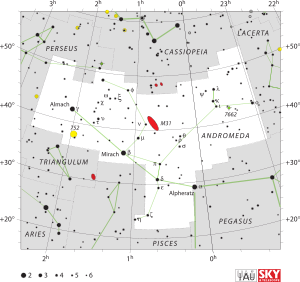R Andromedae
R Andromedae (R And) is a Mira-type variable star in the constellation Andromeda. Its spectral class is type S because it shows absorption bands of zirconium monoxide (ZrO) in its spectrum. It was among the stars found by Paul Merrill to show absorption lines of the unstable element technetium,[11] establishing that nucleosynthesis must be occurring in stars. The SH molecule was found for the first time outside earth in the atmosphere of this star.[12] The star is losing mass due to stellar winds at a rate of 1.09×10−6 M☉/yr.[6]
| Observation data Epoch J2000 Equinox J2000 | |
|---|---|
| Constellation | Andromeda |
| Right ascension | 00h 24m 01.948s[1] |
| Declination | +38° 34′ 37.35″[1] |
| Apparent magnitude (V) | 5.8 - 15.2[2] |
| Characteristics | |
| Spectral type | S3,5e-S8,8e(M7e)[2] |
| B−V color index | 1.97[3] |
| Variable type | Mira[2] |
| Astrometry | |
| Radial velocity (Rv) | -6.40 [4] km/s |
| Proper motion (μ) | RA: −14.98±2.73[1] mas/yr Dec.: −32.64±0.96[1] mas/yr |
| Parallax (π) | 4.1281 ± 0.4616[5] mas |
| Distance | approx. 790 ly (approx. 240 pc) |
| Absolute magnitude (MV) | -5.19[6] |
| Details | |
| Radius | 476±120 - 493±129[7] R☉ |
| Luminosity | 6,300[8] L☉ |
| Surface gravity (log g) | −1.02[9] cgs |
| Temperature | 2,500[9] K |
| Metallicity [Fe/H] | −1.01[10] dex |
| Other designations | |
| Database references | |
| SIMBAD | data |
Variability

R Andromedae shows periodic variations in its brightness approximately every 409 days. The maximum brightness is not the same every cycle and can reach a peak magnitude of mv = 5.8, with the lowest known minima nearly 10 magnitudes fainter. The rise to maximum brightness is approximately twice as fast as the fall to minimum brightness. It is classified as a Mira variable. Those stars contract and expand regularly, changing size and temperature, and this causes the brightness variations.[2]
Properties
R Andromedae has a spectral type that varies as its brightness changes. At a typical maximum it is assigned a spectral type of S5/4.5e. This makes it an S-type star, a red giant similar to class M stars but with unusually strong molecular bands of ZrO in its spectrum compared to the titanium oxide (TiO) bands seen in other cool giants. S stars are intermediate between carbon stars and the more typical oxygen-rich giants. The S5 indicates its relative temperature, while the number after the slash is a measure of the relative C:O ratio, 4.5 meaning carbon is about 97% as abundant as oxygen. ZrO bands in R Andromedae are about twenty times stronger than those of TiO.[13] When it is fainter, the spectral type has been classified as late as S8,8e. On this older classification system for S stars, the number after the comma is an indication of the relative strength of ZrO and TiO bands which used to be considered to show the C:O ratio.[14]
R Andromedae, like all Mira variables, is an asymptotic giant branch star, one that has exhausted its core helium and is burning it in a shell outside the core and hydrogen in a shell closer to the surface. These stars undergo dredge-up events which cause convection of fusion products to the surface and anomalies such as enhanced carbon and zirconium. Asymptotic giant branch stars are very cool and luminous red giants; R Andromedae varies in temperature and luminosity but is typically about 2,500 K and 6,300 L☉. The angular diameter of R Andromedae has been measured at 8.63±1.42 mas and 8.32±1.27 mas on different dates, corresponding to radii of 493±129 R☉ and 476±120 R☉ respectively, assuming a distance of 532 pc.[7]
References
- van Leeuwen, F. (2007). "Validation of the new Hipparcos reduction". Astronomy and Astrophysics. 474 (2): 653–664. arXiv:0708.1752. Bibcode:2007A&A...474..653V. doi:10.1051/0004-6361:20078357. Vizier catalog entry
- Samus, N. N.; Durlevich, O. V.; et al. (2009). "VizieR Online Data Catalog: General Catalogue of Variable Stars (Samus+ 2007-2013)". VizieR On-line Data Catalog: B/GCVS. Originally Published in: 2009yCat....102025S. 1. Bibcode:2009yCat....102025S.
- "R And". SIMBAD. Centre de données astronomiques de Strasbourg. Retrieved October 7, 2018.
- de Bruijne, J. H. J.; Eilers, A.-C. (October 2012), "Radial velocities for the HIPPARCOS-Gaia Hundred-Thousand-Proper-Motion project", Astronomy & Astrophysics, 546: 14, arXiv:1208.3048, Bibcode:2012A&A...546A..61D, doi:10.1051/0004-6361/201219219, A61.
- Brown, A. G. A.; et al. (Gaia collaboration) (August 2018). "Gaia Data Release 2: Summary of the contents and survey properties". Astronomy & Astrophysics. 616. A1. arXiv:1804.09365. Bibcode:2018A&A...616A...1G. doi:10.1051/0004-6361/201833051.
- Guandalini, R. (April 2010). "Infrared photometry and evolution of mass-losing AGB stars. III. Mass loss rates of MS and S stars". Astronomy and Astrophysics. 513: A4. arXiv:1002.2458. Bibcode:2010A&A...513A...4G. doi:10.1051/0004-6361/200911764.
- van Belle, G. T.; et al. (1997). "Angular Size Measurements of Carbon Miras and S-Type Stars". The Astronomical Journal. 114 (5): 2150–2156. Bibcode:1997AJ....114.2150V. doi:10.1086/118635.
- Ramstedt, S.; Olofsson, H. (2014). "The12CO/13CO ratio in AGB stars of different chemical type". Astronomy & Astrophysics. 566: A145. arXiv:1405.6404. Bibcode:2014A&A...566A.145R. doi:10.1051/0004-6361/201423721.
- Ortiz, Roberto; Guerrero, Martín A. (2016). "Ultraviolet emission from main-sequence companions of AGB stars". Monthly Notices of the Royal Astronomical Society. 461 (3): 3036. arXiv:1606.09086. Bibcode:2016MNRAS.461.3036O. doi:10.1093/mnras/stw1547.
- Gáspár, András; Rieke, George H.; Ballering, Nicholas (2016). "The Correlation between Metallicity and Debris Disk Mass". The Astrophysical Journal. 826 (2): 171. arXiv:1604.07403. Bibcode:2016ApJ...826..171G. doi:10.3847/0004-637X/826/2/171.
- Merrill, P. W. (1952). "Technetium in the stars". Science. 115 (2992): 479–489 [484]. Bibcode:1952Sci...115..479.. doi:10.1126/science.115.2992.479. PMID 17792758.
- Yamamura, I.; et al. (January 2000). "Identification of SH ∆v=1 Ro-vibrational Lines in R Andromedae". The Astrophysical Journal. 528 (1): L33–L36. Bibcode:2000ApJ...528L..33Y. doi:10.1086/312420. PMID 10587489.
- Keenan, P. C.; Boeshaar, P. C. (1980). "Spectral types of S and SC stars on the revised MK system". The Astrophysical Journal Supplement Series. 43: 379. Bibcode:1980ApJS...43..379K. doi:10.1086/190673.
- Keenan, Philip C.; Garrison, Robert F.; Deutsch, Armin J. (1974). "Revised Catalog of Spectra of Mira Variables of Types ME and Se". The Astrophysical Journal Supplement Series. 28: 271. Bibcode:1974ApJS...28..271K. doi:10.1086/190318.
